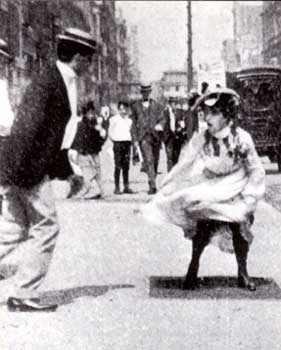Some Films by Edwin S. Porter of the Kinetoscope Era
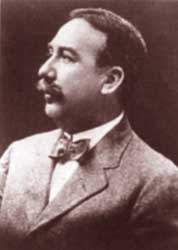 Of the early filmmakers circa 1900 accumulated by Thomas Alva Edison to make movies that were in the main only one- or two-minutes long, most were at best pictorialists or might be regarded as pioneers of newsreels.
Of the early filmmakers circa 1900 accumulated by Thomas Alva Edison to make movies that were in the main only one- or two-minutes long, most were at best pictorialists or might be regarded as pioneers of newsreels.
But Edwin Stanton Porter could almost qualify as "the American Georges Melies," taking everything he could learn from watching Melies' trick-photography films & adapting them to American themes.
Porter directed the world's second megahit. After Melies' Trip to the Moon (1902) the next wildly successful quarter-hour film was Porter's The Great Train Robbery (1903) which effectively defined movie westerns for decades to come.
He was responsible for the first "series comedy" with the Uncle Josh films (1900, 1902), & the important early fantasy, Dream of a Rarebit Fiend (1906).
His versatility ranged from the first significant holiday classic The Night Before Christmas (1905), to such dramatic fare as
Uncle Tom's Cabin 1903. And he was possibly the first director to bring an involving degree of complexity to children's films, with Jack & the Bean Stalk (1902).
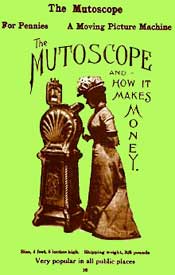 The primary method for viewing films up to 1906 was the Mutoscope or Kinescope, boxes that could entertain one person at a time gazing into a peephole or a window at the moving picture.
The primary method for viewing films up to 1906 was the Mutoscope or Kinescope, boxes that could entertain one person at a time gazing into a peephole or a window at the moving picture.
Although projection devices existed by 1896, & non-motion magic lanter projectors before that, by the time motion picture projectors were made reliable, the kinetoscope parlors didn't want to have to start over with new equipment. And in an environment that kept films inside boxes with peep-windows, there could be no shared theatrical experience, & the quicker each private showing was over the better, so that the next viewer in line could step up to the box.
But by 1907 projection equipment was no longer rare & even small towns were either turning vaudeville theaters into movie houses, or adding a movie screen at the back of the stage in order to show films between vaudeville acts. There was even entirely new construction for full-out movie houses.
At first these theatrical experiences consisted of large clutches of one or two minute films because that's what already existed. But very rapidly longer films were required.
With Porter's former tendency to buck the system trying for longer films, & achieving such remarkable success as early as 1902 with The Great Train Robbery, one would've thought he'd be in like Flint for this new era.
Alas, as innovative as he seemed in 1902, by 1907 he had been surpassed. He still thought action was enough, & gave little thought to characterization. He had become so staid in his approach that Edison would in 1908 let him go.
Porter would go on to work for independent companies & even form his own film company, but never achieved a success anywhere near The Great Train Robbery. Although, to be sure, very little of his last independent works survive. So it's difficult to assess how good or bad he might have been in his post-Edison career. But his last works were commercial & critical failures.
By 1909 critics were more & more assessing story lines & condemned films that had irrational plots or no story at all. By 1915 Porter's filmmaking career was over.
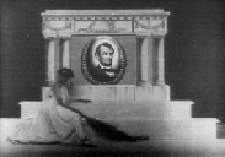 But from 1901 to 1905, Porter was a king. In the environment of film productions under two minutes each, his eight to fourteen minute films were epic. Even some of his early two-minute films rose a bit above the trivial, capturing something either naturalistic or amusing that has lingering appeal even today. But from 1901 to 1905, Porter was a king. In the environment of film productions under two minutes each, his eight to fourteen minute films were epic. Even some of his early two-minute films rose a bit above the trivial, capturing something either naturalistic or amusing that has lingering appeal even today.
At that time, however, the "market" as rigidly controlled by Edison required mostly one & two minute movies, so Porter made lots of those.
The minute-playing The Martyred Presidents (1901) shows a woman kneeling before a memorial on which the faces of presidents killed in office appear one after the other in a cameo, Lincoln, Garfield, McKinley. Then a figure is seen kneeling before a woman dressed as Justice with sword & balancing scale.
Martyred Presidents was evidently intended to muster a bit of sentiment, but it scarcely has any movement & ought to have been a disappointment for anyone who paid a penny to see pictures moving in a mutoscope.
However, according to a contemporary catalog discription, the figure kneeling before Justice is supposed to be one of the presidential assassins, which might've lent a certain sick intrigue to the piece if viewers even knew who that represented.
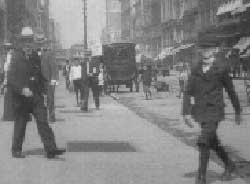 At under two minutes What Happened on Twenty Third Street, New York City (1901) takes its time introducing us to a city street as though it is just one of those reportorial films from filmmakers who thought the fact that you can see people & horse-drawn vehicles & a trolley moving was all that was required to incite interest. At under two minutes What Happened on Twenty Third Street, New York City (1901) takes its time introducing us to a city street as though it is just one of those reportorial films from filmmakers who thought the fact that you can see people & horse-drawn vehicles & a trolley moving was all that was required to incite interest.
A woman is walking toward the viewer with her husband when unexpectedly air from a shaft under the street blows her voluminous dress upward (still at top of page), revealing her underpants. She hastily defends her modesty & continues walking, leaving the frame, & we are left looking at men with their attention riveted by the momentary glimpse.
The scene is so naturalistic that even with this well-timed climax, it would almost seem an accidentally filmed moment. But the woman who is indeed acting was Florence Georgie. The man in the straw hat was Porter's fellow filmmaker, A. C. Abadie.
What Happened on Twenty-Third Street is often compared to Marilyn Monroe's famous "dress blown upward" scene in The Seven Year Itch; & for its day, Porter's film had that kind of sexiness.
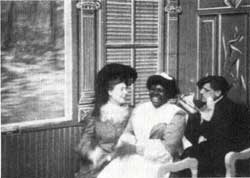 Sex sells, whether a glimpse of undies or a stolen kiss. The minute-comedy set on a train informs us What Happened in the Tunnel (1903), packing in sexual taboo & what is more striking for Porter, three distinct characterizations. Sex sells, whether a glimpse of undies or a stolen kiss. The minute-comedy set on a train informs us What Happened in the Tunnel (1903), packing in sexual taboo & what is more striking for Porter, three distinct characterizations.
He tended to be more master of action or event than of character, but here he shows an ability to capture individuality.
There's a white lady seated beside a black woman, the latter in her housemaid's outfit. Behind them sits a masher (Max Aronson) whose interest in the white lady is reciprocated. They pass through a dark tunnel & when they come out the other side, the masher sees that the maid & the white lady have switched places & he's just smooched a black woman.
The two women laugh & laugh, the man gets physically sick. This is fairly lame as a joke, but the idea that these two women of such differing social positions worked out in advance how to deal with mashers on the train has a certain small appeal.
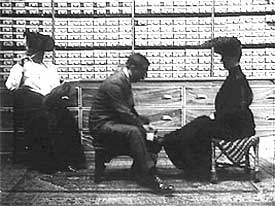 So too The Gay Shoe Clerk (1903) gave the viewer a chance to watch a shoe salesman turn into a masher while waiting on a young lady, & getting less of a reward than he was hoping for. So too The Gay Shoe Clerk (1903) gave the viewer a chance to watch a shoe salesman turn into a masher while waiting on a young lady, & getting less of a reward than he was hoping for.
This one also has the distinction of being the first foot fetish film. Face it, nobody takes a job of getting down on their knees to fondle feet without being a bit bent in the head.
I realized this when I was a young cute thang who could always get quick service in a shoe store. Now that I'm old & plump it's much harder to get one's shoes fitted by those foot-fondling weirdos.
And now that you know it, too, whenever you're buying shoes next, just watch the sales force in action. They leap at the feet of young beauties only, & it's also a quick way to tell which of 'em are gay, as some shoe salesmen will attend the feet of lovely ladies foremost, others of lovely lads foremost.
Porter understands this perfectly, making sure the woman shopping for shoes has a friend with her to insure her safety, then showing much foot-fondling, including in extreme close-up. This gets the salesman so aroused he leaps at the young lady to kiss her assaultively.
It ends with the young woman's friend or guardian taking up her umbrella & whacking the living daylights out of the pervo, which for his fellow foot fetishists peering in at the mutoscope would be just the right climax since adoration of feet is usually attended by eager masochism.
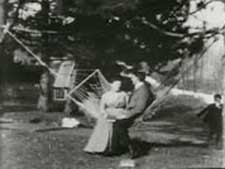 One Porter's earlier "sexploitation" films was Love in a Hammock (1901). The love scene with a girl in a hammock was a cliche of Victorian romantic fiction, 3D stereoscopic cards, pictorial albums, stage plays... One Porter's earlier "sexploitation" films was Love in a Hammock (1901). The love scene with a girl in a hammock was a cliche of Victorian romantic fiction, 3D stereoscopic cards, pictorial albums, stage plays...
So Porter is spoofing popuar imagery. A woman sitting on the edge of a hammock tied between trees is appraoched by a man who sits down, puts his arm around her, & instigates a great deal of kissing.
Of greater interest, however, is the black-clad figure in the tree (looks like a ninja!), another in the background, "bad boy" figures who are aggressive peeping toms. For climax, the fellow on the branch above the hammock tumbles down upon the lovers.
Even these simplistic excursions into one- or two-minute titillations are more substantive than other sexploitative films of the day, as Porter was usually pressing toward narrative. But sexy moving pictures was just about the oldest category, & it was not where Porter's real originality comes into play.
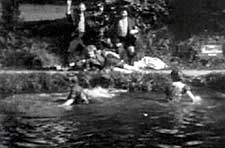 Porter was frequently assisted by stage director George S. Fleming, as he was on Interrupted Bathers (1902).
Porter was frequently assisted by stage director George S. Fleming, as he was on Interrupted Bathers (1902).
A group of young women wearing only their undergarments are in a pond splashing gaily. A fourth young lady is lounging on the banks.
Two tramps (stock characters in such early comedies) slip up upon the scene & the woman lounging on the banks flees, leaving her friends to whatever their fates may be.
Despite being splashed & harrangued to go away, the tramps steal the young women's clothing, throwing them kisses before they hightail it away with the clothing, likely to pawn.
Although their undergarments are not immodest, undergarments are nevertheless undergarments, & we see one of the gals heading home wearing a rain barrel. As for the remaining two gals, we don't see what they find to cover themselves.
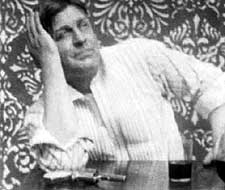 In the blackly comic Burlesque Suicide No. 2 (1902), with George S. Fleming again assisting in the set-up, a man is shown sitting at a table with a gun, a drinking glass, & a bottle of liquor.
In the blackly comic Burlesque Suicide No. 2 (1902), with George S. Fleming again assisting in the set-up, a man is shown sitting at a table with a gun, a drinking glass, & a bottle of liquor.
He attempts to shoot himself in the head, but lacks the courage, so must keep drinking to work up the nerve.
But he gets so drunk, he becomes giddy & happy, & no longer feels like shooting himself.
It seems likely this fellow was a well known vaudevillian at the time. The film is both a record of a vaudeville performance & an "expression film" capturing a range of mood in the man's face.
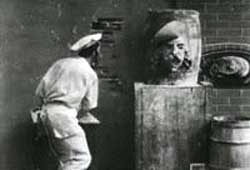 A minute & a half-minute comedy, Fun in a Bakery Shop (1902) is rather more sophisticated than Porters pratfall & sexual innuendo films. A minute & a half-minute comedy, Fun in a Bakery Shop (1902) is rather more sophisticated than Porters pratfall & sexual innuendo films.
In this odd comedy, a baker sees a rat crawling up the wall & hurls a wad of bread dough at it, gluing it to a barrel. He then moulds the wad of dough into the shape of a face.
A second baker seems to disapprove, so our sculpting baker knocks him unconscious, then adds more dough to the face & sculpts a different one. He then mashes more dough onto the sculpture & fashions yet another face, this time a monkey's.
Two bakers enter stage right & left & to show their disapproval stuff the sculpting baker head-first in another barrel. When he gets back to his feet, he blows flour like a big puff of smoke at one of his attackers.
In an environment of copycats & cliches, Fun in a Bakery is at the very least odd & original. However, its inclusion in animation filmographies as an example of "proto-animation" for stop-motion photography is ridiculous, as the dough-faces are being sculpted & molded & at no time are animated.
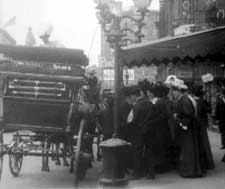 The date on Rector's to Claremont is uncertain, but likely either 1903 or 1904. Records are incomplete on it; it was never copyrighted or commercially released, but turned up in photographic negatives. It's a chase scene from a popular Broadway restaurant (Rector's) heading toward Grant's Tomb.
The date on Rector's to Claremont is uncertain, but likely either 1903 or 1904. Records are incomplete on it; it was never copyrighted or commercially released, but turned up in photographic negatives. It's a chase scene from a popular Broadway restaurant (Rector's) heading toward Grant's Tomb.
Well dressed men & women come out from dining at Rector's, onto the busy business street, & pile onto a horse-drawn cab. Off they go by wealthy houses, along curving lanes, past Grant's Tomb.
One of their party was left behind & is unnoticed chasing along behind the carriage. He nearly catches up, grabs the carriage, but tumbles to the road.
His inability to rejoin his giddy companions adds presumed comedy. In the end they arrive at a house at Claremont, where servants greet them as they leave the carriage, never having noticed their friend's plight.
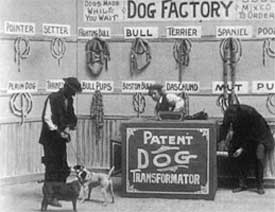 Dog Factory (1904) is an absurdist comedy, a bit under five minutes, comparatively long for a one-joke short of the era. It also happens to be a work of science fiction. Dog Factory (1904) is an absurdist comedy, a bit under five minutes, comparatively long for a one-joke short of the era. It also happens to be a work of science fiction.
Lumiere had already done a "dogs into sausages" film, which was essentially a fairground & vaudeville stunt with nothing particularly remarkable about it, except that Porter would extend the gag with the one novel addition of reversing the process.
At the factory you can pick any dog you want off the wall, where links of frankfurters hang on hooks labeled "Terrier" "Bull" "Setter" & so on. A man brings in a group of dogs which are dropped one by one into the Patent Dog Transformator, & a handle cranked. Issuing out the right side of the Transformator are frankfurter sausages, to be hung on the appropriate peg on the wall.
Another chap comes in & selects Spaniel franks from off the wall. These sausages are put into the transformer & come out the left side as a spaniel.
When a woman selects her sausages, they're transformed into a mean dog, so back in the transformer it goes, becoming sausages again, & she selects another set of links, getting a much sweeter pet that time.
This joke is repeated ad nauseam, without a great deal of variation, else it might've been spectacularly good. It's certainly original for its time. For climax a pugilist comes in & causes the shop owners trouble until dogs are transformated to chase him off.
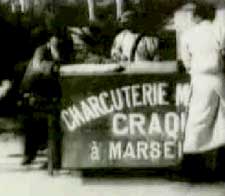 It's worth noting an earlier version of this Dog Factory joke done by the Lumiere brothers, though there's no reason to suppose Porter was copying the Lumiere version. Both adapted the gag from stage comedy. It's worth noting an earlier version of this Dog Factory joke done by the Lumiere brothers, though there's no reason to suppose Porter was copying the Lumiere version. Both adapted the gag from stage comedy.
Comedy was never quite the Lumiere's strong forte. In The Mechanical Butcher (La Charcuterie mecanique, 1895), a large pig is put in the top huge lidded bin. A sign on the front of the bin reads, "Charcuterie Mecaique Craque a Marseile."
The butcher removes cuts of meat from under a smaller lid, handing each cut over the top of the bin to another butcher who stacks them on the table.
The joke is much reduced in impact because it was funnier when the device turned dogs into sausages; funnier still that Porter added another level to the joke & the machine could turn the sausages back into dogs.
Plus the Lumieres just didn't set up the gag to tell the story well. With Porter's "Dog Transformator" you could see operating, but the Lumiere's device has nothing to make it look like anything other than a big trash bin. Without the explanatory signage it might have been a puzzle to figure out what was happening.
copyright © by Paghat the Ratgirl
|
